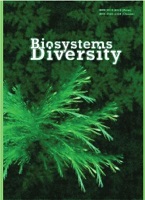Impact of hydrotechnical construction on aquatic ecosystems of the Kiliia branch of the Danube Delta
Impact of hydrotechnical construction on aquatic ecosystems of the Kiliia branch of the Danube Delta
Author(s): A. V. Liashenko, K. Y. Zorina-Sakharova, M. S. Pohorielova, T. M. Sereda, I. I. Abramyuk, V. V. TrylisSubject(s): Energy and Environmental Studies, Human Ecology, Political Ecology, Environmental interactions
Published by: Дніпропетровський національний університет імені Олеся Гончара
Keywords: Transitional waters; affected area; protected area; biotic indices; ecological state;
Summary/Abstract: Resumption of shipping in the Bystryi branch in the Ukrainian part of the Danube Delta, one of the largest aquatic-wetland areas of Europe and the world, has made it necessary to control the anthropogenic impact on the neighboring water areas of the Danube Biosphere Reserve. The objective of the study was comparing the compositions and structure of phytoplankton, microphytobenthos, macrophytes, benthic invertebrates and ichthyofauna of the mouth area of the Bystryi branch with such communities of the mouths of the branches Vostochnyi, Tsyhanka and Starostambulskyi, which are situated in the protected zone and characterized by limited anthropogenic activity. We also determined the correspondence of the descriptors of biotic groups to the categories of the ecological status according to the Water Framework Directive of the EU. The studies were performed in the autumn and summer periods in 2020–2021. We recorded 367 species of animals and plants, the richest biodiversity was seen for the biota of the Bystryi branch – 250 species, and 180–231 species of hydrobionts were found in the undisturbed mouths. We determined 25.3% of shared species for the water areas, and therefore high values of similarity of the species compositions according to Bray-Curtis(47.5% to 81.5%). We determined no significant differences between the groups of the mouths of the examined branches according to most indicators of taxonomic and ecological structure. As the descriptors of ecological status, we chose assemblage indices of phytoplankton and microphytobenthos, which are based on ratios of biomass of functional groups of algae, and also the Macrophyte Biological Index for Rivers, saprobic index of Zelinka & Marvan and Biological Monitoring Working Party Index of Benthic Invertebrates and Representation of Species of Ichthyfauna according to vulnerability to actions of environmental factors. We determined that the range of descriptors of phytoplankton and microphytobenthos corresponded to the “high” ecological status category, such of macrophytes and benthic invertebratesto “good”, and such of ichthyofauna varied “high” to “good”. In general, all the mouth areas were characterized by “good” ecological status. Similarities of the species composition and the structure of biotic communities of the mouths of the studied branches of the delta indicate the absence of negative impact of the deep water shipping on adjacent ecosystems, which may be related to the peculiarities of reactions of groups in the water areas with natural stress, as well as local impact of the hydrotechnical construction.
Journal: Biosystems Diversity
- Issue Year: 30/2022
- Issue No: 4
- Page Range: 359-371
- Page Count: 13
- Language: English

